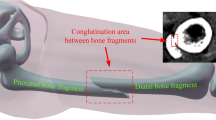Abstract
Joined fragment segmentation for fractured bones segmented from CT (computed tomography) images is a time-consuming task and calls for lots of interactions. To alleviate segmentation burdens of radiologists, we propose a graphics processing unit (GPU)–accelerated 3D segmentation framework requiring less interactions and lower time cost compared with existing methods. We first leverage the normal-based erosion method to separate joined bone fragments. After labeling the separated fragments via CCL (connected component labeling) algorithm, the record-based dilation method is eventually employed to restore bone’s original shape. Besides, we introduce an additional random walk algorithm to tackle the special case where fragments are strongly joined. For efficient fragment segmentation, the framework is carried out in parallel with GPU-acceleration technology. Experiments on realistic CT volumes demonstrate that our framework can attain accurate fragment segmentations with dice scores over 99% and averagely takes 3.47 s to complete the segmentation task for a fractured bone volume of 512 × 512 × 425 voxels.

We propose a GPU accelerated segmentation framework, which mainly consists of normal-based erosion and record-based dilation, to automatically segment joined fragments for most cases. For the remaining cases, we introduce a random walk algorithm for segmentation with a few interactions.

















Similar content being viewed by others
References
Paulano F, Jiménez JJ, Pulido R (2015) Fractured bone identification from ct images, fragment separation and fracture zone detection. In: Developments in medical image processing and computational vision, pp 221–239. Springer
Harders M, Barlit A, Gerber C h, Hodler J, Székely G (2007) An optimized surgical planning environment for complex proximal humerus fractures. In: MICCAI workshop on interaction in medical image analysis and visualization, vol 30
Tomazevic M, Kreuh D, Kristan A, Puketa V, Cimerman M (2010) Preoperative planning program tool in treatment of articular fractures: process of segmentation procedure. In: XII mediterranean conference on medical and biological engineering and computing 2010, pp 430–433. Springer
Neubauer A, Bühler K, Wegenkittl R, Rauchberger A, Rieger M (2005) Advanced virtual corrective osteotomy. In: International congress series, vol 1281, pp 684–689. Elsevier
Beucher S (1979) Use of watersheds in contour detection. In: Proceedings of the international workshop on image processing CCETT
Paulano F, Jiménez JJ, Pulido R (2014) 3d segmentation and labeling of fractured bone from ct images. Vis Comput 30(6-8):939–948
Liu L, Raber D, Nopachai D, Commean P, Sinacore D, Prior F, Pless R, Ju T (2008) Interactive separation of segmented bones in ct volumes using graph cut. In: International conference on medical image computing and computer-assisted intervention, pp 296–304. Springer
Boykov YY, Jolly M-P (2001) Interactive graph cuts for optimal boundary & region segmentation of objects in nd images. In: 8th IEEE international conference on computer vision, 2001. ICCV Proceedings, vol 1, pp 105–112. IEEE
Fornaro J, Székely G, Harders M (2010) Semi-automatic segmentation of fractured pelvic bones for surgical planning. In: International symposium on biomedical simulation, pp 82–89. Springer
Sekiguchi H, Sano K, Yokoyama T (1994) Interactive 3-dimensional segmentation method based on region growing method. Syst Comput Japan 25(1):88–97
Lai J-Y, Essomba T, Lee P-Y et al (2016) Algorithm for segmentation and reduction of fractured bones in computer-aided preoperative surgery. In: Proceedings of the 3rd international conference on biomedical and bioinformatics engineering, pp 12–18. ACM
Lee P-Y, Lai J-Y, Hu Y-S, Huang C-Y, Tsai Y-C, Ueng W-D (2012) Virtual 3d planning of pelvic fracture reduction and implant placement. Biomedical Engineering: Applications, Basis and Communications 24(03):245–262
Nysjö J, Malmberg F, Sintorn I-M, Nyström I (2015) Bonesplit-a 3d texture painting tool for interactive bone separation in ct images
Grady L (2006) Random walks for image segmentation. IEEE Trans Pattern Anal Mach Intell 28(11):1768–1783
Jain AK (1989) Fundamentals of digital image processing, Prentice Hall, Englewood Cliffs
Huicun S (2005) Vertex normal calculation and interactive segmentation of triangle mesh. Journal of Computer Aided Design and Computer Graphics 17(5):1030
Otsu N (1979) A threshold selection method from gray-level histograms. IEEE Transactions on Systems, Man, and Cybernetics 9(1):62–66
Hawick KA, Leist A, Playne DP (2010) Parallel graph component labelling with gpus and cuda. Parallel Comput 36(12):655– 678
NVIDIA®Corporation. Cuda®9.2 programming guide. https://docs.nvidia.com/cuda/archive/9.2/. Accessed 10 May 2018
Kalentev O, Rai A, Kemnitz S, Schneider R (2011) Connected component labeling on a 2d grid using cuda. Journal of Parallel and Distributed Computing 71(4):615–620
Acknowledgments
This work was supported by Major Scientific Research Project of Zhejiang Lab under the Grant No.2018DG0ZX01.
Author information
Authors and Affiliations
Corresponding author
Additional information
Publisher’s note
Springer Nature remains neutral with regard to jurisdictional claims in published maps and institutional affiliations.
Rights and permissions
About this article
Cite this article
Zhang, Y., Tong, R., Song, D. et al. Joined fragment segmentation for fractured bones using GPU-accelerated shape-preserving erosion and dilation. Med Biol Eng Comput 58, 155–170 (2020). https://doi.org/10.1007/s11517-019-02074-y
Received:
Accepted:
Published:
Issue Date:
DOI: https://doi.org/10.1007/s11517-019-02074-y




